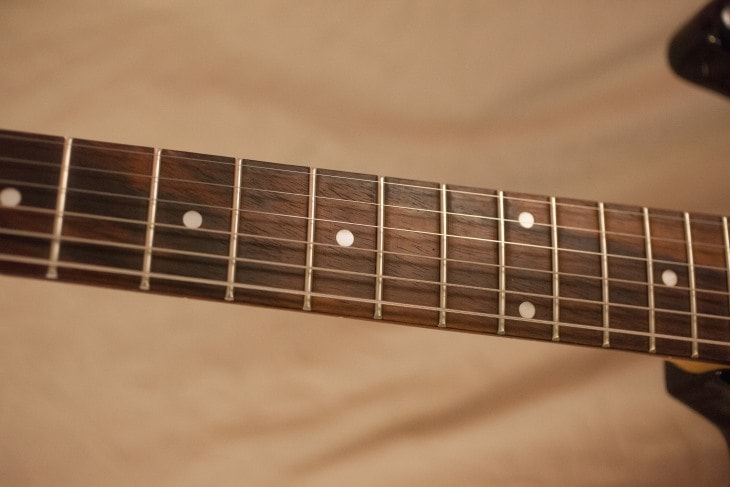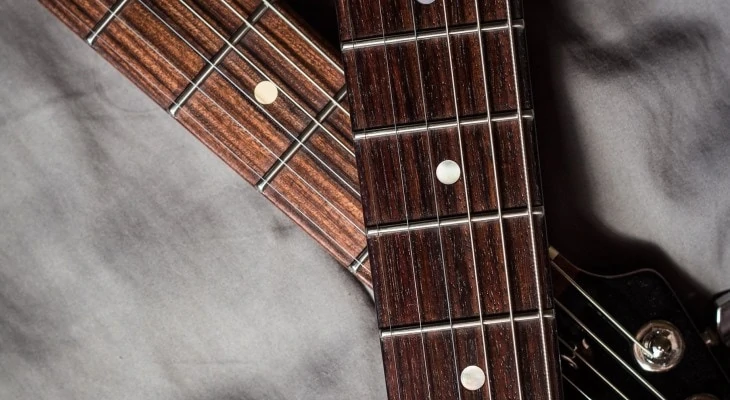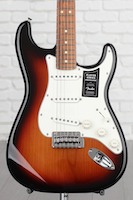Recent changes to the laws surrounding the use of certain types of wood for instruments have seen many of the main manufacturers looking for more sustainable materials.
Historically, rosewood has been one of the most popular used materials for fretboards. However, due to the new regulations, a worthy competitor has emerged – pau ferro.
Differentiating between rosewood and pau ferro can be confusing, as both materials have individual pros and cons. In this article, we’ll compare the old with the new and thoroughly explore the differences between these two popular tonewoods.
In short, pau ferro is a lighter colored sustainable wood that's harder than rosewood with a tighter grain. This results in a slightly brighter and sharper tone. Tonally, it sits between rosewood and ebony (which is even harder), while retaining the warmth that rosewood is known for.
Top 3 - Most Popular Pau Ferro Guitars
Preview | Product | Price |
|---|---|---|
Background
In 2017, CITES introduced a law that restricted the trading of rosewood across certain borders. Up until this point, a large percentage of guitars used this wood, predominantly for fretboards.
The restrictions were initially met with great concern in the guitar-playing community. For decades, rosewood was revered for its exceptional playability, distinguished appearance, and unrivaled tone.
Amongst the alternatives that were tipped to replace rosewood were ebony, maple, laurel, and most significantly, pau ferro. This wood had rarely been used on instruments in the past, and many guitarists were skeptical of its ability to produce the same quality that rosewood had for such a long time.
If you’re reading this article, you probably also have doubts about whether pau ferro is a worthy replacement for rosewood. Let’s take a look at how the two tonewoods compare across the board.
Key Differences

Pau ferro is a sustainable wood type that has been used by manufacturers such as Fender on their modern guitar models. But how does it compare to the trustworthy and much-loved tonewood, rosewood?
Here is a breakdown of the main qualities of pau ferro:
- Considered to be a sustainable material
- Used by Fender on their entire Mexican range
- Tight grain
- Bright, sharp tone
- Fast attack
- Smooth feel underhand
Here is a breakdown of the main qualities of rosewood:
- Most commonly used fretboard wood
- Indian and Brazilian varieties
- Rich, warm tone
- Exceptional durability
- Stain-proof
- Evens out harsh frequencies
- Naturally oily finish
- Extremely smooth and soft
As you can see from the comparison, pau ferro and rosewood share several qualities. Conversely, there are also some noticeable differences between the two fretboard materials.
In truth, pau ferro is very similar to rosewood. To the untrained eye and ear, it would be easy to mistake one for the other. However, some slight differences add up to make a significant difference.
Firstly, pau ferro has a tighter grain than rosewood. This affects its appearance, and also results in a slightly snappier tone with a sharper attack. Rosewood is slightly softer sounding when the note is initially struck.
In terms of warmth, pau ferro and rosewood are evenly matched. Both wood types produce an immersive, thick tone that is strong and prominent across the frequency range of the guitar.
The appearance of the two wood types is noticeably different. Compared to rosewood, pau ferro is significantly lighter in color. It has a caramel-colored pattern running through it, whereas rosewood is more subtly patterned.
Why is Rosewood So Popular?

Pau Ferro is a good alternative to rosewood, and many leading guitar manufacturers are using it as they adjust to the regulations that have been placed to ensure sustainability.
Still, many purists believe that rosewood is the ultimate choice for guitar fretboards. Although it’s becoming rarer to find these days, it's still quite popular and seen on numerous premium guitars like these. There are still many reasons that it is considered to be the premium choice.
Rosewood’s incredible durability is undoubtedly one of the main reasons it has been so popular. Some tonewoods sound and feel great initially, but fade over time. Rosewood remains consistent for long periods.
It also produces a very balanced overall tone for any instrument. Electric and acoustic guitars, bass guitars, and many other instruments benefit from the inclusion of rosewood in their composition.
Is Pau Ferro as Good as Rosewood?
Quality rosewood is definitely much prettier, and easier to play, than pau ferro. It also has a darker, deeper tone, although how much the tone of your guitar is determined by the fretboard is debatable.
The question for any guitarist shouldn’t be which wood is better, but which guitar is better. In many cases, a guitar with a pau ferro fretboard will be a better instrument than one with a rosewood fretboard.
Before the purists grab the torches and pitchforks, consider how much cheaper pau ferro is than real rosewood these days.
Fender, for example, have taken to using pau ferro on many of their intermediate-priced guitars and basses.
The mid-tier (and often pau ferro-adorned) guitars that Fender is manufacturing these days are often far higher in terms of quality and construction than competitors are offering.
I’m a devoted Les Paul player, and even I have to admit that the likes of this Nashville Telecaster turn my head.
Because pau ferro enables guitar manufacturers to offer their products at a lower price without a corresponding dip in quality, I’d argue that pau ferro fretboards compete heavily with rosewood.
For a working musician playing multiple nights per week, a pau ferro fretboard can mean a professional-quality instrument at a lower price.
In some cases, you’re better off with a new guitar that has a pau ferro fretboard than a used one with rosewood. Guitar building techniques have progressed in leaps and bounds in recent years.
It’s worth making the minor concession on your choice of fretboard wood to get the major gain of a high quality instrument.
Conclusion
Pau ferro may not be quite capable of reaching the extremely high standards set by rosewood, but it comes very close. As a sustainable alternative, it is a brilliant option for guitars and other instruments.





I recently got a Fender Player Plus.
And it has a Paul Ferro fretboard.
Yesterday was the first time I played the guitar. The Pau Ferro feels pretty smooth. So far I’m liking it.
Thanks Ross, Great article, it clears up some misinformation I had. Tom – Trout Valley Guitars